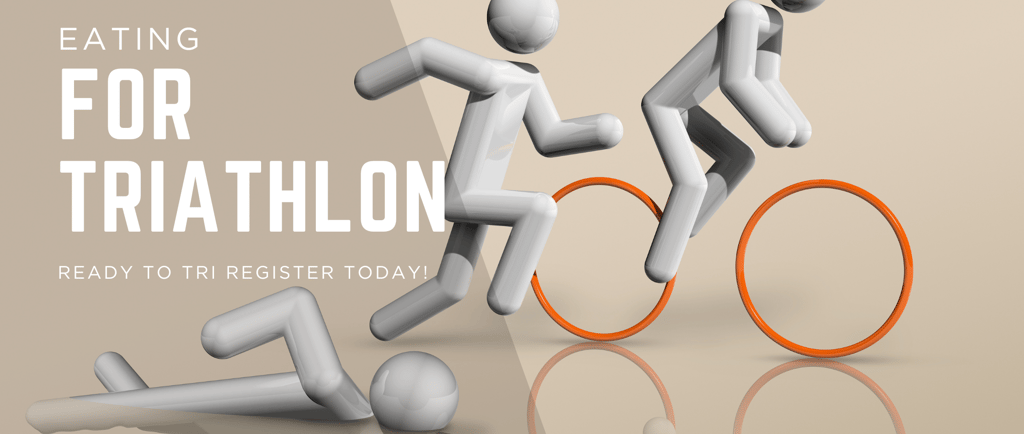Eating for Triathlon: The Three-Sport Balancing Act
Triathlon isn’t your average sport. It’s a beautifully brutal blend of swimming, cycling, and running and it demands a nutrition strategy that’s just as multifaceted. When you train for one sport, you eat to support one set of movements and energy needs. But when you train for three, your plate becomes a performance powerhouse (or a nutritional mess if you’re winging it with cereal and vibes). In this blog, I’ll unpack how to balance fuel for each discipline, manage timing and digestion, and stay energized from pool to pedal to pavement. Whether you’re training for a sprint triathlon or Ironman glory, consider this your roadmap to fueling right.
FUEL LIKE A CHAMPION
Iola Prieto
4/25/20253 min read


🥗 The Foundation:
Triathletes Need More Than the Basics
Let’s start with a fact: Triathlon training burns serious energy. And it’s not just about calories—it's about the right kinds of fuel, at the right time, in the right combinations.
The Big Three Macronutrients:
Carbohydrates: Your main energy source. You burn through carbs like a kid in a candy store. Without them, you’re “bonking” by mile 3.
Protein: Repairs muscle, supports immune health, and keeps you from falling apart (literally).
Fats: For long-distance energy and hormone function—plus, they make food taste amazing.
Now let’s talk about what happens when we try to balance all three sports on one plate.
🏊♀️ Eating for Swimming
Swimming may be the first leg of a triathlon, but from a nutrition standpoint, it often gets neglected. Don’t be fooled—swimming is energy-intensive, especially in cold water. It taxes your upper body and core and can even mask early signs of dehydration.
Fueling Tips for Swimmers:
Pre-swim (light meal/snack 60–90 minutes before):
A banana with peanut butter or oats with berries works great.Post-swim recovery:
Rehydrate first! Then go for carbs + protein like a smoothie with whey, banana, and oats.
💡 Triathlete Truth: Swimming on an empty stomach is like driving with no gas. Sure, you’ll float but not fast.
🚴♀️ Eating for Cycling
Cycling is your mid-tri leg, and arguably the most strategic. Why? Because it’s the best time to eat while moving. You’re less jostled than running, and you can carry a bento box of goodness (or gels, if you’re more minimalist).
Key Nutrition Strategy:
During longer rides (1.5+ hours): Aim for 30–60g of carbs/hour, gradually increasing to 90g/hr for Ironman-level efforts.
Hydration: Electrolyte-rich drinks are gold. Sodium matters here—don't skimp!
🚴♂️ Iola’s Pro Tip: If it sticks to your teeth like gummy glue, maybe skip it mid-ride. Choose options you can chew, swallow, and digest on the go dates, chews, or rice bars.
🏃♂️ Eating for Running
Running is where your nutrition (or lack thereof) gets real. If you’ve under-fueled earlier in the race, this is where your body files a formal complaint cramps, fatigue, or the dreaded porta-potty sprint.
Strategy for Runners:
Pre-run (especially for bricks): Keep it simple—something low-fiber and carb-rich. Try toast and jam or an energy gel 15 mins before.
During long runs: Practice your race nutrition in training. Gels every 30 minutes + sips of water or sports drink = happy legs.
Post-run: Prioritize recovery with a 3:1 carb-to-protein meal—think chicken wrap with a fruit smoothie.
👟 Runner Reality Check: If it’s not tested in training, don’t trust it on race day. Nutrition mistakes hurt more than blisters.
🔁 Bridging the Sports:
Meal Timing, Transitions & Gut Training
Triathlon nutrition isn’t just about what you eat it’s about when. Timing is the key to surviving transitions and avoiding mid-race nausea or the infamous “gut bomb.”
Practice Gut Training:
Train your digestive system to handle carbs during exertion. Start with 30g/hour and build up tolerance over time.
Use Bricks to Simulate Race Day:
Bricks (bike-run sessions) are the best place to test your nutrition. Practice eating on the bike and transitioning to running without regretting that peanut butter wrap.
🍌 Funny but True: Your stomach doesn’t care about your race goals it only cares about what you threw into it an hour ago. Be nice.
💧 Hydration:
Your Fourth Discipline
Hydration isn’t a one-size-fits-all water bottle. Triathletes lose fluid through sweat, breathing, and peeing behind bushes (hey, it happens). You need more than water you need electrolytes, volume, and strategy.
Signs of Underhydration:
Headache
Dark urine
Sluggishness
Muscle cramps
Mood swings that scare even your coach
🧪 Quick Tip: Weigh yourself before and after a long training session. For every 1 kg lost, drink 1.5 L of fluid to replace it.
🥑 Sample Triathlete Meal Plan
(for a 70kg athlete on a training day)
Breakfast (Pre-swim):
Oatmeal with chia seeds, banana, honey
Boiled egg
Green tea
Mid-Morning Snack (Post-swim):
Smoothie: Greek yogurt, berries, protein powder, oats
Handful of almonds
Lunch (Before cycling):
Grilled chicken wrap with hummus and greens
Sweet potato
Electrolyte drink
During Ride (90 min):
1 sports drink bottle
1 energy gel
1 banana
Post-Ride Recovery Snack:
Chocolate milk
Rice cakes with almond butter
Dinner (Post-brick run):
Baked salmon
Quinoa salad with olive oil and veggies
Mixed fruit bowl
Evening Snack (Optional):
Cottage cheese with berries
Herbal (Bush) tea
🧠 Mind Over Menu:
Psychology of Triathlon Eating
Triathletes often fall into food traps: “I trained hard I deserve three burgers” or “I skipped lunch guess I’ll train fasted.” Neither supports long-term performance. Developing a healthy relationship with food is part of training.
🥄 Mental Tip: Think of food as a performance partner, not a reward or punishment.
🎯 Final Takeaway:
You’re a Triathlete—Eat Like One
Eating for triathlon is like training for it multilayered, strategic, and a little messy sometimes. But when done right, nutrition becomes your fourth discipline and your biggest performance enhancer (legal ones, of course!).
Don’t overthink, don’t under-fuel, and don’t skip the fun. You’re not just fueling a body—you’re fueling a dream.
🔥 StayMoving Takeaway:
Swim smart. Ride fueled. Run strong.
And above all: Stay Moving… or they’ll throw dirt on you.
